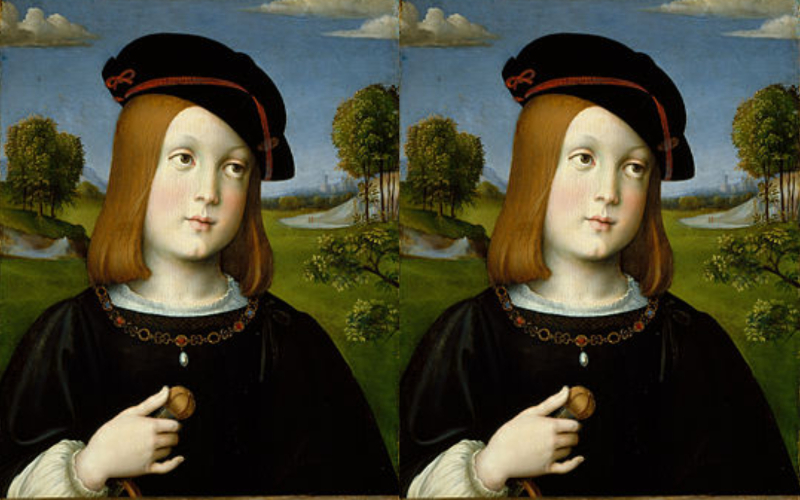Portrait of Federico II Gonzaga (also known as Portrait of Federigo Gonzaga) is a Renaissance portrait of a young boy by Francesco Francia that is housed in New York’s Metropolitan Museum of Art.
The painter as author, the year 1510, and Federico II Gonzaga (portrayed at the age of 10) are thought to be certain, as evidenced by numerous letters.
About the Portrait of Federico II Gonzaga
The bust depicts a young boy wearing a black beret and upper garment. He stands behind a balustrade in front of a landscape, looking rather out of place for the time. According to Francia’s portrait scheme, the body is almost frontal, and the head is in 3/4 profile, looking up to the right.
The boy has medium blond hair and brown eyes, with lower eyelids that hang below strongly arched brows. Despite his childish age, he holds the pommel of a sword in his hand. He wears a rich gold chain with a white pearl around his neck (symbol of innocence). A medal is worn beneath the hatband on the barett.
Despite the fact that it has been transferred from wood to canvas and back, the painting is in excellent condition, i.e. restored. There are remnants of gilding on the shirt (collar and sleeves).
The portrait is stylistically in transition between the Quattrocento (e.g., background and symmetrical bow on the beret) and the High Renaissance (e.g. imprecise shirt folds and asymmetrical bow on the black upper dress).
History
Federico II Gonzaga (born 1500) was the eldest son of Marquis of Mantua Francesco II Gonzaga and his wife Isabella d’Este. During the Italian Wars, the father was captured by the Venetians in 1509 and offered his firstborn as a hostage. The hostage was handed over to Pope Julius II at the end of July 1510.
Francesco Francia painted the boy’s portrait as a memorial painting for his mother in only 12 days at this handover in Bologna. The latter praised the likeness but asked for a slight darkening of the hair color.
Because of the hostage exchange, the House of Gonzaga (Marquisate of Mantua) became dependent on the Holy League (1511), which is why the Gonzaga sided in subsequent battles against her long-time allies France and the House of Este (Duchy of Ferrara). Isabella d’Este (married Gonzaga) commissioned Francesco Francia to paint her own portrait again in 1511.
She gave the two Francia portraits, Mother and Child, to a friend in Ferrara in 1512, who displayed them both as counterparts for discussion at evening events. These events are thought to have been staged by Isabella d’Estes to create a political image following her country’s betrayal.
The boy’s portrait reappeared in 1872 at a Christie’s auction in London, and Herbert Cook identified it as the Francia portrait of the young Federico II Gonzaga in 1903. The painting was finally donated to the Metropolitan Museum by Benjamin Altman in 1913.











